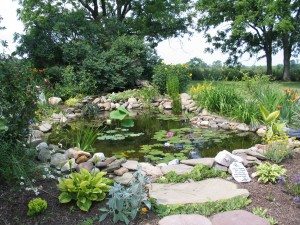Woke up this morning with a chill in the air....gone for a few days are the 80 degree temps. This is what we woke up to this morning.
The leaves are even beginning to fall with the wind blowing. I guess we all know what is in store for us for the next couple months.
Another Red Scarf bud is starting to open in my pond. I find I enjoy the pond plants even more towards the end of the season. It's such a pretty lotus bud.
I probably should get out my sweatshirts and sweaters now. I love fall with its beautiful colors when the leaves begin to turn but don't look forward to what comes after....snow. There are a few things we can start doing to our ponds now since the days are numbered. Here's a list of some fall and winter pond plant care items for the hardy pond plants.
HARDY WATER LILIES
With the lower temperatures during the fall season, you will notice a decrease in water lily blooms and the lily pads turning yellow as the water temperatures cool. It is important at this time to remove the dead leaves and spent blooms to avoid having the debris in the pond over winter. As winter approaches and water temperatures drop, the water lily will go dormant. Remove all dead lily pads and lower the potted lily to the deepest part of the pond or to a water depth of about two feet.
SUBMERGED PLANTS
As long as the submerged plants are below the ice, they will usually survive the winter. Any part of the plant that is allowed to freeze will turn to mush and add unwanted debris to the pond. It is wise to cut these plants back and sink below the surface.
HARDY BOG/MARGINAL PLANTS
Once your hardy marginal plants begin to brown, usually after the first hard frost, prune back excess foliage and discard any decaying material, so it does not compromise the water quality over the winter months. Potted bog plants such as Pickeral and Thalia Dealbata should be placed at a sufficient depth to avoid freezing the crown of the plant. Plants such as Japanese Variegated Iris and Cardinal Flower should be removed from the pond and planted in the yard for the winter. When new growth begins in the Spring, they can be placed back in the pond for the summer. Most of the other hardy bog plants can be left as they are and will return the following spring.
 Its essential to achieve a natural ecological balance in your pond. We can achieve this naturally with a few key steps. Adding submerged plants play an important role in achieving success by removing excessive nutrients in the water and provide oxygen during the day for fish and other aquatic creatures. The most important role is removing excessive nutrients that help reduce the incidence of algae which is the nightmare of most water gardeners. They starve out the algae by utilizing all the mineral salts which the algae normally feeds from.
Its essential to achieve a natural ecological balance in your pond. We can achieve this naturally with a few key steps. Adding submerged plants play an important role in achieving success by removing excessive nutrients in the water and provide oxygen during the day for fish and other aquatic creatures. The most important role is removing excessive nutrients that help reduce the incidence of algae which is the nightmare of most water gardeners. They starve out the algae by utilizing all the mineral salts which the algae normally feeds from.
Submerged pond plants oxygenate the water during the day, but at night the process is reversed and carbon dioxide is produced. This only becomes a problem if your night time temperatures are quite warm and you overstock your pond with fish. Generally the more submerged plants you put in your pond the better the pond balance will be.
Algae likes full sunlight so in addition to the submerged plants add floating plants, waterlily foliage or bog plants to cover at least one third to one half of your pond's surface, but no more than one half to be successful in controlling the green suspended algae.
There is a balance to achieve so make sure you don't cover too much of your ponds surface with plants or it will inhibit the submerged plants from growing.
The recommendation is to have 1 bunch of submerged plants per every 2 to 3 square feet of surface area. We sell submerged plants by the bunch so you receive 6-8 plants per bunch. You can determine your surface area by multiplying your length by the width of your pond. This gives you a general idea.
A similar calculation is made to determine the quantity of floating plants and waterlilies for your pond. Determine the square footage and remember you don't want more than half of the surface covered so that the submerged plants receive plenty of light.
Once you create the formula for water clarity the rest is easy.